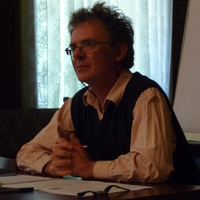
Douglas Robinson
Doug Robinson is broadly interested in human communication as grounded in human social interaction, and specifically in the ways in which the circulation of shared evaluative affect through the collective body-becoming-mind of a group constitutes a living and constantly self-adjusting and self-regulating organism. The study of this homeostatic interaction, which he calls the somatic exchange, is the basis of his somatic theory.
If somaticity is about feeling as our primary channel of social regulation, its "public" aspect, what Kenneth Burke calls "dramatistic" interaction in groups, would be performativity--based especially on J. L. Austin and his followers, including Grice, Felman, Butler, and others.
This broad theoretical orientation tends to get focused in specific books and articles into specific disciplinary niches: literary theory, translation theory, language theory, cultural theory, rhetorical theory, gender theory, and so on. Doug's books on American literature and culture--American Apocalypses (1985), Ring Lardner and the Other (1992), and No Less a Man (1994)--are also, and in some sense primarily, literary and cultural theory, and the latter two are both gender theory as well. The Translator's Turn (1991) first introduced the somatics of language and translation; in the books on translation from the late 1990s--Translation and Taboo (1996), What Is Translation? (1997), Becoming a Translator (1997), Translation and Empire (1997), Western Translation Theory from Herodotus to Nietzsche (1997), and Who Translates? (2001)--somaticity and performativity tended to get buried rhetorically, but are at work subtextually.
Doug's books of the 2000s return to somaticity and performativity in overt ways: Performative Linguistics (2003) and Introducing Performative Pragmatics (2006) carry the latter in their titles, and PL has two chapters on somatics; Estrangement and the Somatics of Literature: Tolstoy, Shklovsky, Brecht (2008) carries the former in its title. The Estrangement book is one volume in a series, including Translation and the Problem of Sway (John Benjamins, 2011) and First-Year Writing and the Somatic Exchange (Hampton Press, 2012); Feeling Extended: Sociality as Extended Body-Becoming-Mind (MIT Press, 2013) and Displacement and the Somatics of Postcolonial Culture (Ohio State University Press, 2013); are both also part of that series.
Beginning with Schleiermacher's Icoses: Social Ecologies of the Different Methods of Translating (Zeta Books, 2013) he begins to develop a theory of what he calls "icosis," from Aristotle's term eikos "plausible," ta eikota "the plausibilities." Aristotle notes that, given a choice between a story that is true but implausible and one that is false but plausible, we will almost always choose the latter, because plausibility is constructed for us by the community. Thus icosis is "group plausibilization"--the fourth step in somatic theory, after (1) somatic marking, (2) the somatic transfer of somatic markers, and (3) the somatic exchange. Doug develops icotic theory further in The Dao of Translation (Routledge, 2015), The Deep Ecology of Rhetoric in Mencius and Aristotle (SUNY Press, 2016), and Semiotranslating Peirce (Tartu Semiotics Library, 2016).
Forthcoming books include Critical Translation Studies (Routledge, 2017) and Exorcising Translation: Towards an Intercivilizational Turn (Bloomsbury, 2017)
Phone: 852-3411 7320
Address: Arts Faculty Dean's Office
OEW1102
Ho Sin Hang Campus
Hong Kong Baptist University
Kowloon Tong, Hong Kong
If somaticity is about feeling as our primary channel of social regulation, its "public" aspect, what Kenneth Burke calls "dramatistic" interaction in groups, would be performativity--based especially on J. L. Austin and his followers, including Grice, Felman, Butler, and others.
This broad theoretical orientation tends to get focused in specific books and articles into specific disciplinary niches: literary theory, translation theory, language theory, cultural theory, rhetorical theory, gender theory, and so on. Doug's books on American literature and culture--American Apocalypses (1985), Ring Lardner and the Other (1992), and No Less a Man (1994)--are also, and in some sense primarily, literary and cultural theory, and the latter two are both gender theory as well. The Translator's Turn (1991) first introduced the somatics of language and translation; in the books on translation from the late 1990s--Translation and Taboo (1996), What Is Translation? (1997), Becoming a Translator (1997), Translation and Empire (1997), Western Translation Theory from Herodotus to Nietzsche (1997), and Who Translates? (2001)--somaticity and performativity tended to get buried rhetorically, but are at work subtextually.
Doug's books of the 2000s return to somaticity and performativity in overt ways: Performative Linguistics (2003) and Introducing Performative Pragmatics (2006) carry the latter in their titles, and PL has two chapters on somatics; Estrangement and the Somatics of Literature: Tolstoy, Shklovsky, Brecht (2008) carries the former in its title. The Estrangement book is one volume in a series, including Translation and the Problem of Sway (John Benjamins, 2011) and First-Year Writing and the Somatic Exchange (Hampton Press, 2012); Feeling Extended: Sociality as Extended Body-Becoming-Mind (MIT Press, 2013) and Displacement and the Somatics of Postcolonial Culture (Ohio State University Press, 2013); are both also part of that series.
Beginning with Schleiermacher's Icoses: Social Ecologies of the Different Methods of Translating (Zeta Books, 2013) he begins to develop a theory of what he calls "icosis," from Aristotle's term eikos "plausible," ta eikota "the plausibilities." Aristotle notes that, given a choice between a story that is true but implausible and one that is false but plausible, we will almost always choose the latter, because plausibility is constructed for us by the community. Thus icosis is "group plausibilization"--the fourth step in somatic theory, after (1) somatic marking, (2) the somatic transfer of somatic markers, and (3) the somatic exchange. Doug develops icotic theory further in The Dao of Translation (Routledge, 2015), The Deep Ecology of Rhetoric in Mencius and Aristotle (SUNY Press, 2016), and Semiotranslating Peirce (Tartu Semiotics Library, 2016).
Forthcoming books include Critical Translation Studies (Routledge, 2017) and Exorcising Translation: Towards an Intercivilizational Turn (Bloomsbury, 2017)
Phone: 852-3411 7320
Address: Arts Faculty Dean's Office
OEW1102
Ho Sin Hang Campus
Hong Kong Baptist University
Kowloon Tong, Hong Kong
less
Related Authors
Joseph Carroll
University of Missouri - St. Louis
Galen Strawson
The University of Texas at Austin
Bill Bowring
Birkbeck College, University of London
Steven Pinker
Harvard University
Na'ama Pat-El
The University of Texas at Austin
Don Ross
University College Cork
Javier Díaz Noci
Pompeu Fabra University
Marija Todorova
Hong Kong Baptist University
Dylan Trigg
Central European University
Cynthia R . Nielsen
University of Dallas
InterestsView All (100)










Uploads
Books by Douglas Robinson
More generally, the book’s aim is to offer a commentary that is both critical and corrective, but that is also in the end celebratory, showing Schleiermacher’s hermeneutic innovations in the strongest possible light.
Following a “commentary” chapter (1) consisting of fifty numbered passages (covering the entire lecture) with questions directing the attention, the book offers two “critique” chapters focusing on problems: the “bad” analogical reasoning (2) and the patriotism, moralism, and mysticism (3). Chapter 4 explores the parallels between Schleiermacher’s foreignism and the “other” German Romantic foreignism, namely Novalis’s Befremdung, which issues into modernist theories of estrangement (Shklovsky’s ostranenie, Brecht’s Verfremdung)—parallels at which Schleiermacher hints, but so vaguely as to raise the question of whether he was even aware of doing so. Chapters 5 and 6 read a series of specific passages closely in terms of icotic theory, the analogies in Chapter 5 and Schleiermacher’s general understanding of language, literature, translation, and society in Chapter 6. "
This book is divided into three essays covering the refugee experience, colonization and decolonization, and intergenerational trauma. Each essay contains a review of empirical studies of its main topic, a study of literary representations of that topic, and a study of postcolonial theoretical spins. The literary representations in the refugee essay are a novel and short story by the Haitian writer Edwidge Danticat; in the colonization essay a short film by Javier Fesser and a novella by Mahasweta Devi (translated by Gayatri Chakravorty Spivak); and in the intergenerational trauma essay novels by James Welch and Toni Morrison and a short story by Percival Everett. The first essay’s theoretical spins include Deleuze and Guattari on nomad thought and Iain Chambers on migrancy; the second’s, Nietzsche’s Genealogy of Morals and theories of postcolonial affect in Bhabha and Spivak; the third’s, work on historical trauma by Cathy Caruth and Dominic LaCapra.
Douglas Robinson is Dean of Arts and Chair Professor of English at Hong Kong Baptist University."
As Ori and Rom Brafman use the term in their 2008 book Sway, however, sway is defined specifically as the kind of irrational and undesirable kind of distortive force that rational people are expected to avoid or resist. In traditional approaches to translation, this sort of sway would include ideological or other bias as well as forces that we might lump together under the rubric “bad theory,” such as various atavistic literalisms that unconsciously sway the inattentive or inexperienced translator to translate the meaning of each word in turn before moving on to the next.
The recent work of Lawrence Venuti on interpretants and Mona Baker on narrativity suggests some intriguing ways of integrating the study of normative and non-normative sway using the same conceptual framework—and those ways lie at the core of this book. The basic premise of the book is that Venuti’s interpretants and Baker’s narratives are extremely important and to a large extent convergent conceptualizations of translator sway—but that neither theorist explores those conceptualizations deeply or complexly enough. The book, then, is an attempt to look more closely at interpretants and narratives, especially through the tools of rhetoric and hermeneutics, and thus to offer an expanded model for the study of translator sway that remains true to the spirit of Venuti’s and Baker’s work."
This book begins with two assumptions, both taken from Tolstoy's late aesthetic treatise What Is Art? (1898): that there is a malaise in culture, and that literature's power to "infect" readers with the moral values of the author is a possible cure for this malaise. Exploring these ideas of estrangement within the contexts of earlier, contemporary, and later critical theory, Robinson argues that Shklovsky and Brecht follow Tolstoy in their efforts to fight depersonalization by imbuing readers with the transformative guidance of collectivized feeling. Robinson's somatic approach to literature offers a powerful alternative to depersonalizing structuralist and poststructuralist theorization without simply retreating into conservative rejection and reaction.
Both a comparative study of Russian and German literary-theoretical history and an insightful examination of the somatics of literature, this groundbreaking work provides a deeper understanding of how literature affects the reader and offers a new perspective on present-day problems in poststructuralist approaches to the human condition.
Published in 2008 by the Johns Hopkins University Press.
Published by Avain in 2007.
Blog: http://pentinpeijaat.blogspot.com/
Reviews:
- http://www.nytimes.com/2009/05/10/books/review/Schillinger-t.html
- http://genderacrossborders.com/2009/04/24/review-when-i-forgot-elina-hirvonen/
- http://www.independent.co.uk/arts-entertainment/books/reviews/when-i-forgot-by-elina-hirvonen-trans-douglas-robinson-760017.html
- http://americareads.blogspot.com/2009/06/review-elina-hirvonens-when-i-forgot.html
Published in 2006 by Routledge.
Published in 2003 by Routledge.
Published in 2001 by State University of New York Press.
Review: http://muse.jhu.edu/journals/comparative_literature_studies/v041/41.2merrill.html
* how to translate faster and more accurately
* how to deal with arising problems and stress
* how the market works
* includes a wide variety of lively activities and exercises to facilitate the learning of both theory and practice
* includes a detailed Teachers Guide - contains suggestions for discussion and activities and hints for the teaching of translation.
Becoming a Translator has been specifically designed for introductory undergraduate courses in the theory and practice of translation. It will also be of interest to professional translators and students of translation and language.
Reviews:
http://www.translator-lounge.com/2009/02/18/becoming-a-translator/
http://muse.jhu.edu/journals/language/v082/82.1ilangovan.pdf
eBook:
http://www.ebookmall.com/ebook/80019-ebook.htm
Originally published by Routledge in 1997 as Becoming a Translator: An Accelerated Course. This blurb refers to the revised second edition, published by Routledge in 2003. A third edition is in the works."
Published in 1997 by Kent State University Press
Published in 1997 by St. Jerome Press.
Published in 1996 by Northern Illinois University Press.
Review: http://findarticles.com/p/articles/mi_qa3612/is_199710/ai_n8766312/
Published in 1994 by Bowling Green University Popular Press.
Published in 1992 by Oxford University Press (New York).
Review: http://findarticles.com/p/articles/mi_m2455/is_n1_v31/ai_15361570/
Published in 1991 by the Johns Hopkins University Press.
Review: http://findarticles.com/p/articles/mi_qa3612/is_199501/ai_n8714660/
More generally, the book’s aim is to offer a commentary that is both critical and corrective, but that is also in the end celebratory, showing Schleiermacher’s hermeneutic innovations in the strongest possible light.
Following a “commentary” chapter (1) consisting of fifty numbered passages (covering the entire lecture) with questions directing the attention, the book offers two “critique” chapters focusing on problems: the “bad” analogical reasoning (2) and the patriotism, moralism, and mysticism (3). Chapter 4 explores the parallels between Schleiermacher’s foreignism and the “other” German Romantic foreignism, namely Novalis’s Befremdung, which issues into modernist theories of estrangement (Shklovsky’s ostranenie, Brecht’s Verfremdung)—parallels at which Schleiermacher hints, but so vaguely as to raise the question of whether he was even aware of doing so. Chapters 5 and 6 read a series of specific passages closely in terms of icotic theory, the analogies in Chapter 5 and Schleiermacher’s general understanding of language, literature, translation, and society in Chapter 6. "
This book is divided into three essays covering the refugee experience, colonization and decolonization, and intergenerational trauma. Each essay contains a review of empirical studies of its main topic, a study of literary representations of that topic, and a study of postcolonial theoretical spins. The literary representations in the refugee essay are a novel and short story by the Haitian writer Edwidge Danticat; in the colonization essay a short film by Javier Fesser and a novella by Mahasweta Devi (translated by Gayatri Chakravorty Spivak); and in the intergenerational trauma essay novels by James Welch and Toni Morrison and a short story by Percival Everett. The first essay’s theoretical spins include Deleuze and Guattari on nomad thought and Iain Chambers on migrancy; the second’s, Nietzsche’s Genealogy of Morals and theories of postcolonial affect in Bhabha and Spivak; the third’s, work on historical trauma by Cathy Caruth and Dominic LaCapra.
Douglas Robinson is Dean of Arts and Chair Professor of English at Hong Kong Baptist University."
As Ori and Rom Brafman use the term in their 2008 book Sway, however, sway is defined specifically as the kind of irrational and undesirable kind of distortive force that rational people are expected to avoid or resist. In traditional approaches to translation, this sort of sway would include ideological or other bias as well as forces that we might lump together under the rubric “bad theory,” such as various atavistic literalisms that unconsciously sway the inattentive or inexperienced translator to translate the meaning of each word in turn before moving on to the next.
The recent work of Lawrence Venuti on interpretants and Mona Baker on narrativity suggests some intriguing ways of integrating the study of normative and non-normative sway using the same conceptual framework—and those ways lie at the core of this book. The basic premise of the book is that Venuti’s interpretants and Baker’s narratives are extremely important and to a large extent convergent conceptualizations of translator sway—but that neither theorist explores those conceptualizations deeply or complexly enough. The book, then, is an attempt to look more closely at interpretants and narratives, especially through the tools of rhetoric and hermeneutics, and thus to offer an expanded model for the study of translator sway that remains true to the spirit of Venuti’s and Baker’s work."
This book begins with two assumptions, both taken from Tolstoy's late aesthetic treatise What Is Art? (1898): that there is a malaise in culture, and that literature's power to "infect" readers with the moral values of the author is a possible cure for this malaise. Exploring these ideas of estrangement within the contexts of earlier, contemporary, and later critical theory, Robinson argues that Shklovsky and Brecht follow Tolstoy in their efforts to fight depersonalization by imbuing readers with the transformative guidance of collectivized feeling. Robinson's somatic approach to literature offers a powerful alternative to depersonalizing structuralist and poststructuralist theorization without simply retreating into conservative rejection and reaction.
Both a comparative study of Russian and German literary-theoretical history and an insightful examination of the somatics of literature, this groundbreaking work provides a deeper understanding of how literature affects the reader and offers a new perspective on present-day problems in poststructuralist approaches to the human condition.
Published in 2008 by the Johns Hopkins University Press.
Published by Avain in 2007.
Blog: http://pentinpeijaat.blogspot.com/
Reviews:
- http://www.nytimes.com/2009/05/10/books/review/Schillinger-t.html
- http://genderacrossborders.com/2009/04/24/review-when-i-forgot-elina-hirvonen/
- http://www.independent.co.uk/arts-entertainment/books/reviews/when-i-forgot-by-elina-hirvonen-trans-douglas-robinson-760017.html
- http://americareads.blogspot.com/2009/06/review-elina-hirvonens-when-i-forgot.html
Published in 2006 by Routledge.
Published in 2003 by Routledge.
Published in 2001 by State University of New York Press.
Review: http://muse.jhu.edu/journals/comparative_literature_studies/v041/41.2merrill.html
* how to translate faster and more accurately
* how to deal with arising problems and stress
* how the market works
* includes a wide variety of lively activities and exercises to facilitate the learning of both theory and practice
* includes a detailed Teachers Guide - contains suggestions for discussion and activities and hints for the teaching of translation.
Becoming a Translator has been specifically designed for introductory undergraduate courses in the theory and practice of translation. It will also be of interest to professional translators and students of translation and language.
Reviews:
http://www.translator-lounge.com/2009/02/18/becoming-a-translator/
http://muse.jhu.edu/journals/language/v082/82.1ilangovan.pdf
eBook:
http://www.ebookmall.com/ebook/80019-ebook.htm
Originally published by Routledge in 1997 as Becoming a Translator: An Accelerated Course. This blurb refers to the revised second edition, published by Routledge in 2003. A third edition is in the works."
Published in 1997 by Kent State University Press
Published in 1997 by St. Jerome Press.
Published in 1996 by Northern Illinois University Press.
Review: http://findarticles.com/p/articles/mi_qa3612/is_199710/ai_n8766312/
Published in 1994 by Bowling Green University Popular Press.
Published in 1992 by Oxford University Press (New York).
Review: http://findarticles.com/p/articles/mi_m2455/is_n1_v31/ai_15361570/
Published in 1991 by the Johns Hopkins University Press.
Review: http://findarticles.com/p/articles/mi_qa3612/is_199501/ai_n8714660/